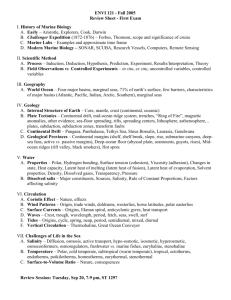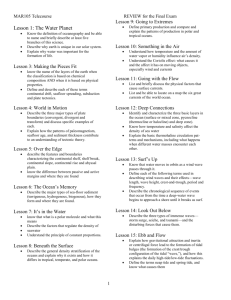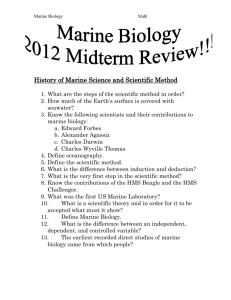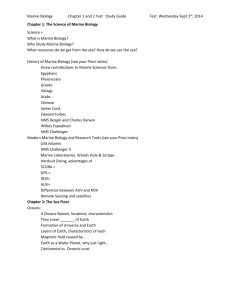Marine Biology Exam Review: Chapters 1-3, 5-6
advertisement
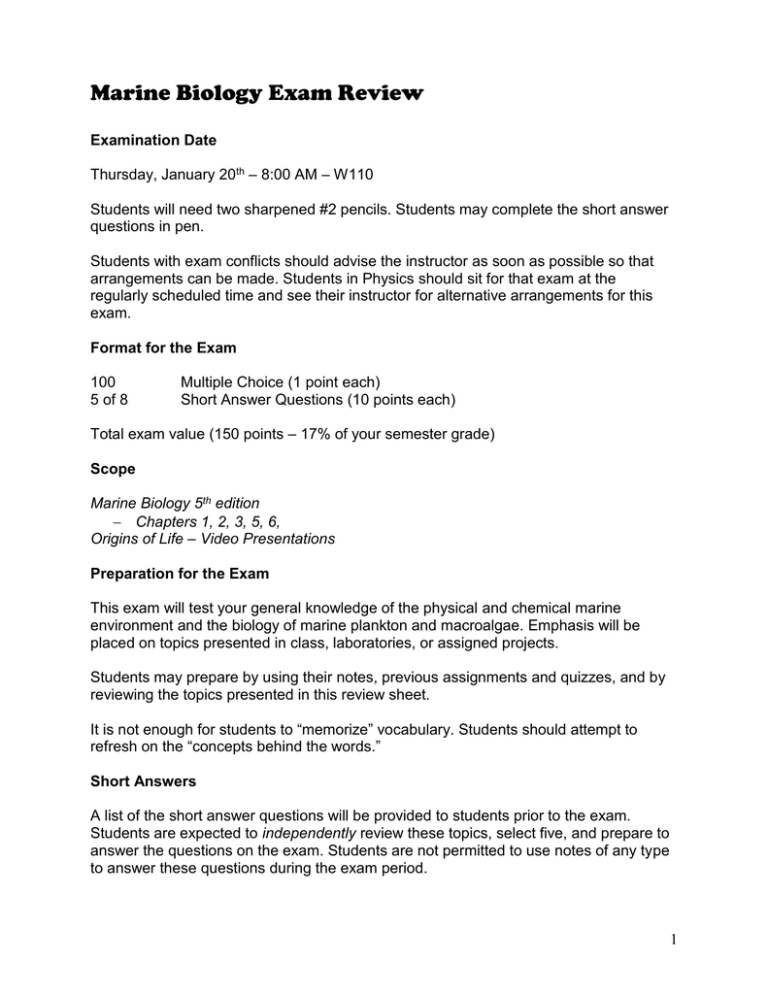
Marine Biology Exam Review Examination Date Thursday, January 20th – 8:00 AM – W110 Students will need two sharpened #2 pencils. Students may complete the short answer questions in pen. Students with exam conflicts should advise the instructor as soon as possible so that arrangements can be made. Students in Physics should sit for that exam at the regularly scheduled time and see their instructor for alternative arrangements for this exam. Format for the Exam 100 5 of 8 Multiple Choice (1 point each) Short Answer Questions (10 points each) Total exam value (150 points – 17% of your semester grade) Scope Marine Biology 5th edition Chapters 1, 2, 3, 5, 6, Origins of Life – Video Presentations Preparation for the Exam This exam will test your general knowledge of the physical and chemical marine environment and the biology of marine plankton and macroalgae. Emphasis will be placed on topics presented in class, laboratories, or assigned projects. Students may prepare by using their notes, previous assignments and quizzes, and by reviewing the topics presented in this review sheet. It is not enough for students to “memorize” vocabulary. Students should attempt to refresh on the “concepts behind the words.” Short Answers A list of the short answer questions will be provided to students prior to the exam. Students are expected to independently review these topics, select five, and prepare to answer the questions on the exam. Students are not permitted to use notes of any type to answer these questions during the exam period. 1 Concepts for Review - “One Hundred Questions” The following questions will be a helpful study guide for the Marine Science Mid-term Examination. Key words are listed in bold type. Chapter 1: The Science of Marine Biology & Earth is Born QUESTIONS What significant technologies have added to our understanding of the marine environment? What inventions first allowed individuals to spend extended time underwater? What is the scientific method? What are the steps of the scientific method? What are the limitations of the scientific method? What is a hypothesis? What is the difference between induction and deduction? What is the difference between a controlled variable and an experimental variable? What is the purpose of an experiment? What is a scientific theory? How old is the Earth? How did the Earth form? How did the moon form? How did liquid water come to exist on the early Earth? What is the significance of comet and meteor impacts to the presence of life on the early Earth? What is the significance of cyanobacteria to life’s existence on Earth? What is a stromatolite? KEY TERMS scientific method induction deduction hypothesis experiment variable controlled variable experimental variable theory HMS Challenger JOIDES Resolution SONAR SCUBA aqualung diving bell remotely operated vehicles autonomous underwater vehicles chronometer R/V Flip Alvin Aquarius remote sensing controlled variable experimental variable theory 2 Chapter 2: The Sea Floor & Life on Earth QUESTIONS What are the characteristics of the Earth’s early atmosphere? How are the Earth’s layers structured? What are the differences between continental crust and oceanic crust? How do the ocean basins compare to one another with respect to size? What is Alfred Wegener’s hypothesis of continental drift? What is the theory of plate tectonics? What evidence supports the theory of plate tectonics? What is the difference between a convergent plate boundary and a divergent plate boundary? What geological features predominate when two plates converge? diverge? What does the presence of magnetic anomalies suggest about the formation of the Earth’s oceanic crust at the mid-ocean ridges? What are the major topographical features of the ocean floor? What is the “Ring of Fire?” What is a hot spot? What is the difference between an active continental margin and a passive continental margin? What is an extremophile? How are various extremophiles classified? What geologic features are associated with the various plate boundaries throughout the world? KEY TERMS density Pangea inner core outer core mantle crust lithosphere asthenosphere mesosphere continental crust oceanic crust continental drift plate tectonics lithospheric plates Alfred Wegener convergent boundary divergent boundary mid-ocean ridge fault transform fault trench sea-floor spreading magnetic anomalies rift rift valley subduction subduction zone island arc shear boundary hot spot continental margins continental shelf continental slope continental rise abyssal plain shelf break seamount guyot deep sea fan submarine canyon active margin passive margin central rift valley hydrothermal vent black smoker 3 Chapter 3: Chemical and Physical Features of Seawater and the World Ocean QUESTIONS What are the properties of water? What is hydrogen bonding? What factors affect the salinity of the world’s oceans? What affect does salinity have on the freezing point of water? What is the rule of constant proportions? What is the relationship between a thermocline, a halocline, and a pycnocline? What is the photic zone? How does the ocean affect the absorption or penetration of light? What are the general trends of pressure, temperature, salinity, light intensity, oxygen, and density with depth? What is the oxygen minimum zone? How does the carbon dioxide buffering system control the pH of the ocean? What is the pH range of seawater? What affect does water’s heat capacity have on local climates? What is thermohaline circulation? What are the wavelengths of tides, wind driven waves, and tsunamis? What is the period and fetch of a wave? What is the relationship between wave speed, wavelength, and wave period? What are the parts of a wave? How do water molecules move as a wave passes? Where are the major wind belts located on the Earth? What is the Coriolis effect? What are the differences among currents, countercurrents, and continental boundary currents? What is upwelling? What is the relationship between the Ekman layer and Ekman transport? What are tides? What causes tides? What causes variability in the tidal cycles or patterns in a particular area? What is the difference between a spring tide and a neap tide? What are the differences among diurnal, semidiurnal, and mixed semidiurnal tide patterns? What causes seas, swells, and surf? What factors contribute to the devastation that can be caused by tsunamis? What physical factors in the ocean can cause upwelling and downwelling? What are the different zones in the ocean with respect to where living things can survive? KEY TERMS chemical property physical property hydrogen bonds evaporation density latent heat of evaporation latent heat of fusion specific heat evaporative cooling polar covalent viscosity surface tension universal solvent cohesion adhesion salinity parts per thousand practical salinity units (psu) halocline thermocline pycnocline depth profile pressure light transparency atmosphere (unit) biogeographical zones stability water column stratification surface layer intermediate layer deep & bottom layers instability overturn downwelling thermohaline circulation Coriolis effect surface currents trade winds westerlies polar easterlies gyre 4 Ekman spiral Ekman transport equatorial currents gyres waves crest trough wavelength wave period wave height fetch seas swells surf tsunami photic zone euphotic zone disphotic zone aphotic zone oxygen minimum zone current countercurrent continental boundary current El Niño upwelling conduction convection Chapter 5: The Microbial World QUESTIONS What is a prokaryote? What are the parts of a typical prokaryotic cell? What are the evolutionary relationships among Bacteria, Archaea, and Eukarya? What is the difference between autotrophs and heterotrophs? In what ways do autotrophs make their own food? In what ways do heterotrophs obtain their food? What is light-mediated ATP synthesis? How have cyanobacteria contributed to the atmosphere of Earth? What structures do cyanobacteria create? What is a harmful algal bloom (HAB) and how might one affect humans? What photosynthetic pigments are used by unicellular organisms and their respective colors? What is a heterocyst? What is nitrogen fixation? What is an extremophile? Where might extremophiles be found on our planet? List the characteristics of algae and marine unicellular eukaryotes. Understand variations in diatom size, color, and mode of reproduction. How do diatoms reproduce? What is the difference between sexual and asexual reproduction? Compare the size, shape, composition, nutrition, and movement of the following marine unicellular eukaryotes: diatoms, silicoflagellates, coccolithophorids, cryptophytes, dinoflagellates, foraminiferans, radiolarians, and ciliates. cell wall capsule peptidoglycan pili plasmid flagella cilia extremophile halophile methanogen thermoacidophile autotroph photoautotroph chemoautrotroph heterotroph light-mediated ATP synthesis cyanobacteria chlorophyll a phycocyanin phycoerythrin pigment red tides harmful algal bloom (HAB) stromatolites nitrogen fixation heterocyst bacteriorhodpsin algae diatom frustule epitheca hypotheca centrate pennate auxospore silica diatomaceous ooze bloom biogenous ooze siliceous ooze calcareous ooze zooxanthellae cellulose carotenoid dinoflagellate silicoflagellates coccolithophorid coccolith protozoan foraminiferan pseudopodia radiolarian ciliate microbial loop detritus plankton 5 Chapter 6: Marine Primary Producers QUESTIONS Draw and label the basic structure of a marine macroalga. Compare and contrast the relative abundance, pigmentation, distribution, and economic importance of green, brown, and red algae. Interpret a diagram showing the life history of a marine macroalga and explain how it displays an alternation of generations Explain how marine macroalgae are harvested and used by people. thallus stipe blade pneumatocyst holdfast sexual reproduction asexual reproduction diploid haploid gamete spore sporophyte gametophyte alternation of generations algin carageenan agar 6
